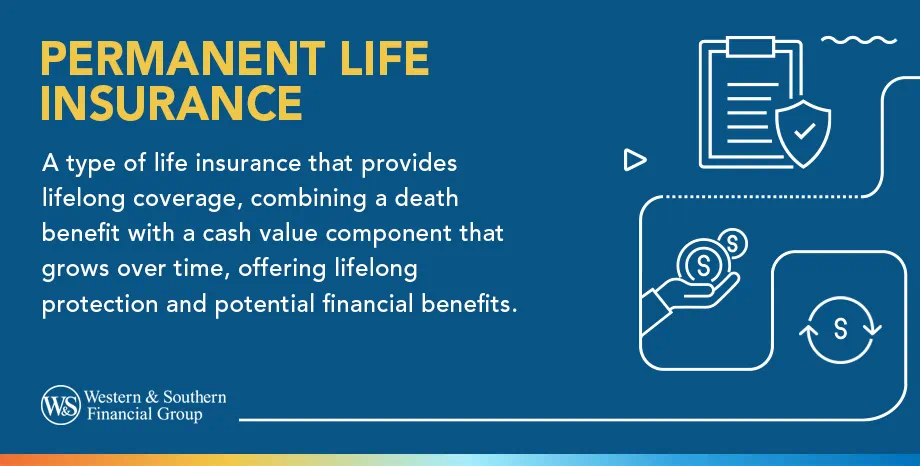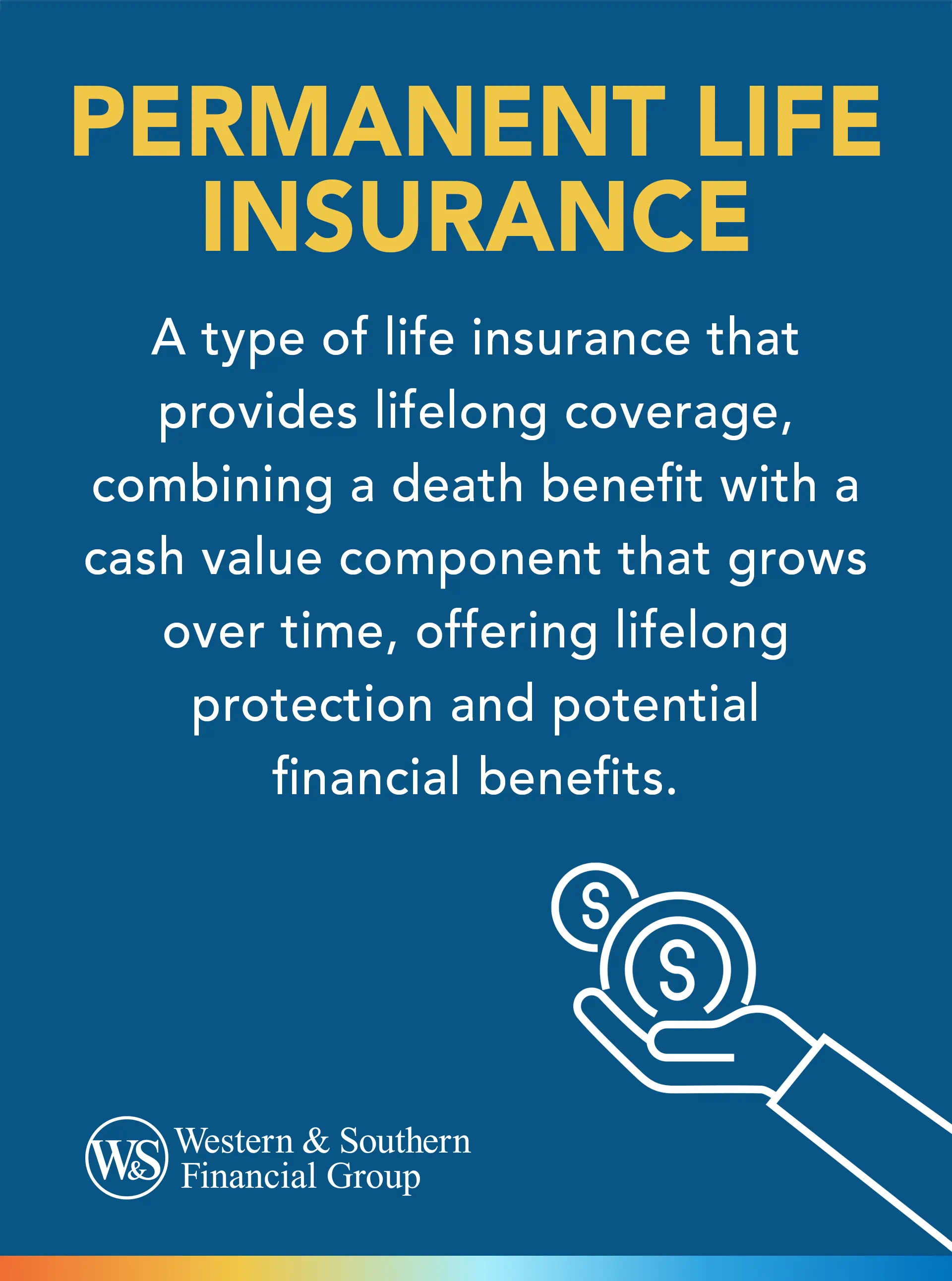

Table of Contents
- Permanent Life Insurance Defined
- What Are the Types of Permanent Life Insurance?
- How Does Permanent Life Insurance Work?
- Advantages of Permanent Life Insurance
- Disadvantages of Permanent Life Insurance
- How Much Does Permanent Life Insurance Cost?
- Who Should Consider Permanent Life Insurance?
- How to Choose the Right Permanent Life Insurance
- Conclusion
- Frequently Asked Questions
Key Takeaways
- Permanent life insurance provides lifelong coverage as long as premiums are paid and builds cash value over time.
- There are several types, including whole life, universal life, and variable life insurance.
- Premiums are generally higher than term life insurance but offer additional benefits.
- Cash value can be accessed through loans or withdrawals during the policyholder's lifetime.
- It best suits those with long-term financial needs or complex estate planning goals.
Permanent Life Insurance Defined
Permanent life insurance offers lifelong coverage, combining a death benefit with a cash value component that grows over time, helping provide protection and potential financial benefits.
Key Features of Permanent Life Policies
- Lifelong Coverage: Permanent life insurance ensures that your beneficiaries receive a death benefit no matter when you pass away, provided premiums are paid.
- Cash Value Component: A portion of your premium builds cash value over time, which can be borrowed or withdrawn but may reduce the death benefit.
- Level Premiums: Permanent life insurance premiums are typically fixed and do not increase with age or health changes.
- Policy Loans and Withdrawals: You can borrow against your policy's cash value, providing a source of funds in emergencies or for other financial needs. Withdrawals are also possible but may affect the death benefit portion and incur taxes.
- Investment Options: Some types of permanent life insurance, like variable life insurance, allow you to invest the cash value in various investment options, potentially increasing its growth.
What Are the Types of Permanent Life Insurance?
Permanent life insurance comes in a few versions, differing in premium flexibility and cash value management. These are the most common types:
Whole Life Insurance
Whole life insurance is the oldest and most straightforward version of a permanent policy. The premium stays the same as when you first bought your policy. The cash value grows at a guaranteed fixed rate, which lets you know how much you'll earn every year ahead of time. Some life insurance companies pay annual dividend payments to their whole life insurance policies.
Universal Life Insurance
Universal life insurance lets you change your premium to pay more in some months than others. You must pay enough into the policy to keep up with the insurance costs, or your policy could expire. Your insurer will tell you how much you must pay to maintain the insurance over time.
Market interest rates determine a policy's cash value, so the amount earned could change each year. Universal life policies are more risky than whole life policies but are often more flexible.
Variable Life Insurance
With Variable Life Insurance, you can invest your cash value in sub-accounts, which are similar to mutual funds. Sub-accounts represent different investment strategies, such as equity, bond, or balanced funds. Your return may be higher if your investments do well. If your investments do poorly, your return will be lower, and you could even lose money. The premiums for variable life insurance policies stay the same over time.
Variable Universal Life Insurance
Variable Universal Life Insurance policies combine variable and universal life insurance features. Like Universal Life, you can adjust your premiums each year, and like Variable Life, you invest your cash value mutual fund like sub accounts.
Indexed Universal Life Insurance
Indexed Universal Life Insurance (IUL Insurance) offers a unique combination of permanent coverage, flexible premiums, and tax-advantaged cash value growth, allowing you to allocate your cash value growth to the performance of a broad securities index.
How Does Permanent Life Insurance Work?
Permanent life insurance is designed to provide lifelong coverage, meaning it remains in effect for the insured's entire life as long as the required premiums are paid. This type of insurance also includes a savings element known as cash value, which accumulates over time and can be utilized by the policyholder.
Premiums
- Fixed Premiums: In most permanent life insurance policies, premiums are fixed and do not increase with age or changes in health. This predictability can be beneficial for long-term financial planning.
- Payment Flexibility: Some policies, particularly universal life insurance, offer flexible premium payments, allowing policyholders to adjust their payments within certain limits.
Death Benefit
- The death benefit is the amount paid to beneficiaries upon the insured's death. This benefit is typically tax-free and can cover various expenses such as funeral costs, debts, and dependents' living expenses.
Cash Value
- Accumulation: A portion of the premium goes into a cash value account, which grows tax-deferred over time. Depending on the type of policy, the growth rate can be fixed or variable.
- Access: Policyholders can access the cash value through loans or withdrawals. Loans must be repaid with interest; otherwise, the outstanding amount will be deducted from the death benefit. Withdrawals may reduce the death benefit and could incur taxes.
Advantages of Permanent Life Insurance
Several potential benefits are associated with permanent life insurance policies. Here are some of the advantages to consider when weighing your options:
- Lifelong Coverage: Permanent life insurance coverage remains active as long as you pay your premiums, helping ensure lifelong protection.
- Cash Value Growth: Permanent life insurance policies build cash value, while term life insurance policies do not.
- Tax Advantages: Life insurance cash value grows tax-deferred, meaning you don't owe income taxes on the gains as long as you keep the money in your policy.
- Policy Loans and Withdrawals: Permanent life insurance policies may offer ways to access the death benefit while you're still alive. In addition, if you take out your cash value gains through a policy loan, you don't owe income taxes (though the insurer will charge interest on your outstanding loan balance).
Disadvantages of Permanent Life Insurance
While permanent life insurance can benefit many situations, it might not fit everyone's needs. Here are a few potential drawbacks:
- Higher Premiums: A permanent policy will charge significantly more at first than a term life policy with the same death benefit.
- Increased Complexity: Permanent life insurance often has more rules, features, and fees than term coverage.
- Limited Investment Flexibility. With whole life and universal life policies, you cannot change how your cash value is invested. While you can choose which investment funds to use with variable and variable universal life, your options are limited to what's available with the insurer.
- Drawbacks for using cash value. Borrowing or withdrawing your cash value may result in interest or taxes and can reduce your death benefit.
How Much Does Permanent Life Insurance Cost?
The cost of permanent life insurance varies widely based on several factors. Here's a detailed breakdown of what influences the premiums and what you can expect:
Age: Purchasing a policy at a younger age typically results in lower premiums since insurers view younger individuals as lower risk.
Health: Your health status significantly affects the cost. Insurers typically require a medical exam and will review your medical history. Healthy individuals pay lower premiums, whereas those with health issues may incur higher costs.
Gender: Women often pay lower premiums than men because they have longer life expectancies.
Coverage Amount: Choosing a higher death benefit results in higher premiums, so assess the coverage needed to protect your beneficiaries adequately.
Type of Policy:
- Whole Life Insurance: Usually has higher premiums because it offers guaranteed cash value growth and fixed premiums.
- Universal Life Insurance: Premiums can be more flexible, but the cost may vary based on the interest rates applied to the cash value.
- Variable Life Insurance: Can be more expensive due to the investment component, which also introduces higher investment risk.
Policy Riders: Adding riders, such as long-term care or waiver of premium, increases the cost of the policy.
Lifestyle: Premiums are influenced by smoking, occupation, and hobbies, with higher rates for smokers and those with high-risk jobs or hobbies.
Who Should Consider Permanent Life Insurance?
Permanent life insurance is ideal for individuals with specific long-term financial needs and goals. Here are some examples:
- Parents with Young Children: Permanent life insurance can benefit individuals who want to help ensure their children are financially secure even if they pass away. For example, a parent who wants to cover their child's education expenses or provide for their living costs until adulthood may find this life insurance protection valuable.
- Business Owners: Entrepreneurs who want to secure the future of their business should consider permanent life insurance. It can fund a buy-sell agreement, ensuring the company continues smoothly if an owner dies. For instance, a small business co-owner can use the policy's cash value to buy out the deceased partner's share, preventing disruption in business operations.
- Estate Planners: Individuals with significant estates concerned about estate taxes can use permanent life insurance to cover these taxes, ensuring that more of their estate is passed on to heirs. For example, a person with an extensive property portfolio might use the death benefit to pay estate taxes, preserving the properties for their descendants.
- Individuals with Long-Term Dependents: Those who have dependents with special needs or elderly parents may find permanent life insurance beneficial. For example, a person who wants to ensure their special needs child has lifelong financial support can rely on the policy's death benefit to fund a trust for the child's care.
Permanent life insurance helps offer long-term financial planning with security and investment benefits, adaptable to diverse needs and situations.
How to Choose the Right Permanent Life Insurance
Choosing the right permanent life insurance option out of the various types of life insurance policies involves several critical steps to ensure it meets your financial goals and needs. Here's a detailed guide to help you make an informed decision:
1. Assess Your Financial Needs and Coverage Goals
- Coverage Amount: Determine how much coverage you need to protect your beneficiaries. Consider debts, income replacement, education costs, and long-term financial goals.
2. Compare Policy Features
- Premiums: Evaluate the cost of premiums and ensure they fit within your budget. Consider if you prefer fixed premiums or need the flexibility to adjust payments.
- Cash Value Growth: Compare different policies to see how cash value grows. Some offer guaranteed growth, while others depend on market performance.
- Policy Loans and Withdrawals: Understand the terms for borrowing against or withdrawing from the cash value. Check the interest rates and any potential impact on the death benefit.
3. Consider the Insurance Company's Reputation
- Financial Strength: Select a company with a strong financial rating to ensure they can meet long-term commitments. For insights, look at ratings from agencies like A.M. Best, Moody's, and Standard & Poor's.
- Customer Service: Research the company's customer service record, including claims handling and responsiveness. Read reviews and ask for recommendations.
4. Consult with a Financial Planner
- Expert Advice: A certified financial planner can help you assess your needs, compare policies, and choose the best option for your financial goals.
- Personalized Planning: They can provide personalized advice based on your unique financial situation, helping you integrate the policy into your broader financial plan.
5. Review Policy Riders and Options
- Additional Benefits: Look at optional riders that can enhance your policy, such as accelerated death benefits, long-term care riders, or waiver of premium riders.
- Customization: Choose riders that add value to your policy based on your personal circumstances and needs.
6. Read the Fine Print
- Policy Terms: Carefully review the policy terms, conditions, exclusions, and limitations. Ensure you understand the policy's flexibility and any penalties for early withdrawal or non-payment.
Conclusion
Whether planning for your family's future, securing your business, knowing the types of permanent life insurance can help you choose the best policy. Permanent life insurance offers a unique combination of lifelong coverage and potential cash value growth, making it an attractive option for various long-term financial needs.
Footnotes
- Interest is charged on loans, they may generate an income tax liability, reduce the Account Value and the Death Benefit, and may cause the policy to lapse. The policy may be issued as a Modified Endowment Contract (MEC) for tax purposes. Any withdrawals or surrenders could result in a taxable event.
- Withdrawals may be subject to charges, withdrawals of taxable amounts are subject to ordinary income tax, and, if taken before age 59½, may be subject to a 10% IRS penalty.
Frequently Asked Questions
At what age should you get permanent life insurance?
The optimal age to get permanent life insurance largely depends on individual circumstances. However, purchasing a policy earlier in life can be advantageous due to lower premiums and a longer time for cash value growth.
Many financial experts suggest considering permanent life insurance in your 20s or 30s when you're likely to be healthier and have growing financial responsibilities, such as starting a family or buying a home.
It's never too late to consider permanent life insurance if it aligns with your financial goals, as the need for lifelong coverage and potential cash value accumulation can arise at various life stages.
Is cash value in a permanent life insurance policy guaranteed?
The cash value in a permanent life insurance policy is usually subject to the policy's performance and the insurer's investment strategy and is generally not guaranteed. Whole life insurance offers a guaranteed minimum cash value, but universal and variable life insurance may fluctuate with market conditions. Policyholders should review their policy details to understand the guarantees and potential risks of their cash value life insurance.
Is the death benefit from permanent life insurance taxable?
The death benefit from permanent life insurance is generally not subject to income tax for the beneficiaries. However, if the death benefit is paid out in installments or retained by the insurer and earns interest, that interest may be taxable. Additionally, any estate taxes could apply if the death benefit pushes the estate's value over the federal or state estate tax exemption limits.
What is the difference between term & permanent life insurance?
The key difference lies in the duration of coverage and the inclusion of a cash value component in permanent life insurance, which term life insurance lacks.
Term life insurance covers a specific period, usually 10, 20, or 30 years. It pays a death benefit only if the insured passes away during that term, making it generally more affordable but without any savings component.
On the other hand, permanent life insurance provides lifelong coverage with a cash value component that grows over time and can be accessed through loans or withdrawals, though it usually has higher premiums.


















